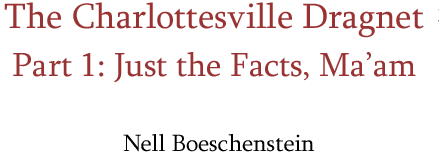

 ith the fiftieth anniversary of Brown v. Board of
Education and the reopening, after forty-nine years, of the Emmett Till murder
case, racial politics are in the air. Perhaps it is the resonance of these
events that leaves us preoccupied by a DNA dragnet that recently targeted young
black males in our community, Charlottesville, Virginia, where we live and
publish. Prompted by what we have heard and read on the subject, Archipelago
has decided to try something new: think locally, meaning, within our own city
limits. Our hypothesis is that the more we explore our immediate environment,
the more we will discover that questions arising locally are applicable
internationally. Such queries propose that the dragnet is not simply an isolated
news event, but rather the symptom of a greater world climate wherein the word
“rapist” can be substituted for “terrorist,” and “community,” “The United
States.”
ith the fiftieth anniversary of Brown v. Board of
Education and the reopening, after forty-nine years, of the Emmett Till murder
case, racial politics are in the air. Perhaps it is the resonance of these
events that leaves us preoccupied by a DNA dragnet that recently targeted young
black males in our community, Charlottesville, Virginia, where we live and
publish. Prompted by what we have heard and read on the subject, Archipelago
has decided to try something new: think locally, meaning, within our own city
limits. Our hypothesis is that the more we explore our immediate environment,
the more we will discover that questions arising locally are applicable
internationally. Such queries propose that the dragnet is not simply an isolated
news event, but rather the symptom of a greater world climate wherein the word
“rapist” can be substituted for “terrorist,” and “community,” “The United
States.”
A serial rapist has been active in our area since 1997. Beginning in the winter of 2003, Charlottesville Police Chief Timothy Longo decided to collect DNA samples from (primarily) young black men who, because of various identifying factors, were suspects in the case. The procedure involved collecting a DNA sample by taking a swab of saliva from the inside of the mouth (a buccal swab). Of one hundred ninety-seven suspects, all but ten consented to the swab. The objections of these ten, however, raised a national controversy over conflicting issues: racial profiling, Fourth Amendment rights and how best to protect a community from an attacker—questions which led to the suspension of the dragnet in April 2004.
While the Charlottesville dragnet received a fair amount of coverage in the local and national press, Archipelago thinks that the underlying themes have not been sufficiently addressed in other forums. This is the first of a series in which we will explore the events surrounding the Charlottesville dragnet and its aftermath. This installment will lay out a summary of events and main characters, culled from national and local news services, from the start of the dragnet to its suspension. Later, we will explore in depth the personalities and motivations of the “main characters,” and learn what we can about the effect this dragnet has had on our community. But we will cross the broader bridges when we come to them. For now, it’s just the facts, ma’am.
![]()
The serial rapist who has eluded Charlottesville law enforcement since 1997 has been definitively linked to six assaults in the area, the latest having been in April 2003. Police believe he could be responsible for other, more recent assaults as well. In winter 2003, frustrated by countless dead-end leads in the case, Chief Longo and the Charlottesville Police Department took the step of initiating a DNA dragnet by taking buccal swabs from a list of suspects, hoping thereby to identify and apprehend the rapist.
Their first step was compiling a list of names. Six hundred ninety names were brought into question via five identifying factors:
1) A “call for service;”
2) A call to Crime Stoppers;
3) A call to an investigator;
4) The Police Department’s Record Management System;
5) A policeman’s personal encounter “based on reasonable suspicion.”
Four hundred suspects were quickly eliminated and never approached for swabbing. While the numbers don’t add up, a remaining one hundred ninety-seven were so recognized based on three further criteria:
1) Ninety-nine were said to resemble the police department’s composite sketch;
2) One hundred sixteen had been reported for “suspicious behavior;”
3) Seventy-five were so named based on their criminal records.
Over the past year, city police took buccal swabs from one hundred eighty-seven men (one hundred eight-five of whom were black, two of whom were Hispanic). These men complied with the request for their DNA samples. The remaining ten men refused. All those swabbed were cleared of suspicion.
From the start of the dragnet, Chief Longo stipulated that once the swabs had been tested and returned as “negative” from the state DNA labrotory in Richmond (where all DNA samples taken by law enforcement are processed), the samples would be destroyed and their identifying bar code not entered into any database that could be used at a later date. If the suspect so desired, his swab could be returned to him, although Longo admitted this choice was not always made clear. The greatest complicating factor, however, was that all DNA samples were to be taken on a voluntary basis.
The implications (and complications) of the word “voluntary” became apparent when two students at the University of Virginia, Michael Townes and Steven Turner, refused to submit to swabbing. The two men argued that the request was not necessarily “voluntary,” and so, raised Fourth Amendment questions. They maintained that when a man refused to give the swab, he was branded more of a suspect than those who readily complied. By speaking up, Townes and Turner drew national attention to the issue, put pressure on the local black community to voice their objections to the dragnet, and forced the police department to rethink their procedure. Said Turner, “Because the suspect is black, every black man is a suspect. What are we going to do about this as a community?”
Criticsim came to a head in April 2004. Together with M. Rick Turner (of no relation to Steven Turner), Dean of the University of Virginia’s Office of African-American Affairs, Chief Longo organized a forum at the university to discuss the situation and growing national criticism. As a follow up, Chief Longo and Dr. Turner, arranged a closed meeting for community leaders at the Mount Zion Baptist Church to discuss the city-wide effects.
According to accounts, Chief Longo was receptive to criticism. As he said at the forum, “I’m not a black man. I haven’t stood in Steven Turner’s shoes. I don’t pretend to.” It was the chief’s willingness to compromise and rethink his policies that left Dean Turner more optimistic about the situation, despite his having been wary going into the meeting. When asked to describe Chief Longo, Dr. Turner said, “I think he’s decent man. I think he has a good heart. He’s not how you would depict a Southern police chief of old.”
Chief Longo proved Dr. Turner right when, on April 16, 2004, he suspended the first stage of the DNA sweep and revised the criteria for taking a buccal swab. While “officer discretion” will still be allowed “where an arrest or investigative detention” has led police to believe that the person in question is a suspect, such “discretion” will no longer be based solely on individual citizens’ reports of men resembling the police composite. Instead, said Chief Longo, the police will be responsible for independently determining whether a reported person is acting suspiciously or resembles the composite.
After criticizing the police for not making suspects fully aware that they were not legally bound to submit to the swabbing, Kent Willis, Executive Director of the American Civil Liberties Union of Virginia praised Chief Longo’s response. Following the community meeting at Mount Zion and the suspension of the dragnet, Chief Longo also earned praise locally from Mayor Maurice Cox and Pastor Bruce Beard of the Transformation Ministries First Baptist Church. But how, in the coming months, the residual effects of this dragnet will unfold in Charlottesville’s black and white communities, and how (and if) Longo decides to continue the dragnet are the questions that remain to be answered. This is what we will address in coming issues.
![]()
Further reading:
“Chief Longo’s Memo Regarding Buccal Swabs/Citizen Contacts”
“City of Charlottesville: Charlottesville Police Defend DNA Testing After Allegations of Racism”
“Will DNA dragnet affect college diversity?”
“City of Charlottesville: Police to Restrict DNA Testing”
“City of Charlottesville: Police in Charlottesville Suspend ‘DNA Dragnet’”